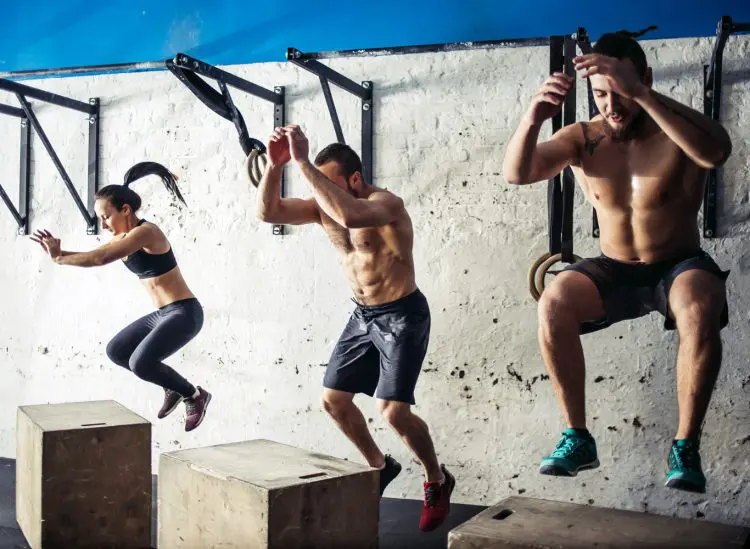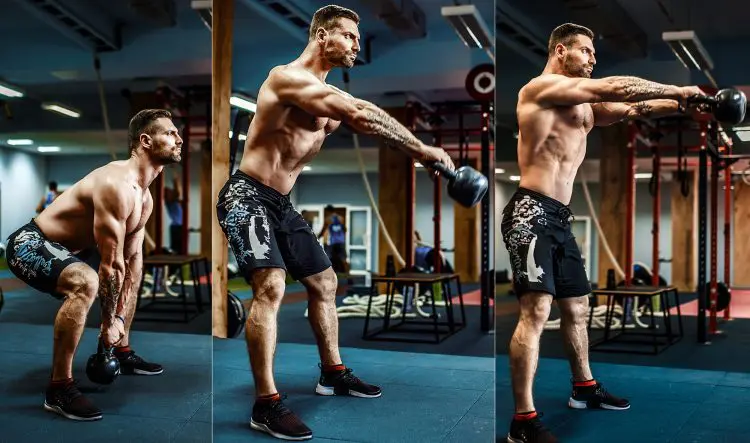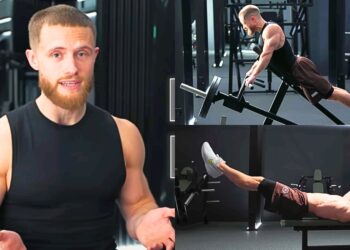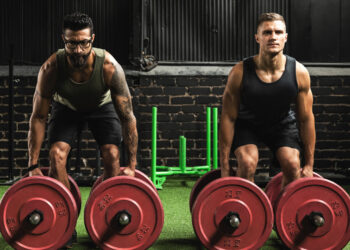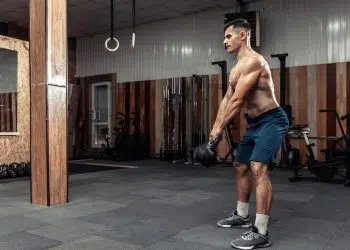Having strong legs isn’t enough. Explosiveness and agility in your wheels are a must for optimal functionality. Box jumps are one of the best exercises for building these qualities. In the exercise, you jump from the floor onto an elevated surface, like a box.
Box jumps have the uncanny ability to exhaust you irrespective of if you perform the exercise at the beginning, middle, or end of your workout. If you have ever wondered why box jumps have gained such a big cult, it’s because of the following benefits:
- Improved explosiveness and athleticism.
- Better vertical jumping ability.
- Improved leg-eye coordination.
- Increased endurance and stamina.
- Enhanced lower body and core strength.
- Better cardiovascular health.
Box Jumps: The King Of Plyometric Exercises
Plyometrics, also known as jump training or plyos, involves exercises in which muscles exert maximum force in short intervals to increase the rate of force development and explosiveness.
Let’s get it out of the way – box jumps are cool. We’d go as far as to say box jumps are among the most badass exercises. Don’t believe us? Answer this for yourself – Which Instagram Reel would you rather watch and share with your friends? A jacked dude performing dumbbell bench presses or a ripped guy jumping on top of a stack of boxes.
No matter how experienced you are, you should not try your hands (or rather legs) at the unintimidating box without some practice. It’s not uncommon to see people scrape their shins or fall on their faces while going too hard on the exercise.
Level Up Your Fitness: Join our 💪 strong community in Fitness Volt Newsletter. Get daily inspiration, expert-backed workouts, nutrition tips, the latest in strength sports, and the support you need to reach your goals. Subscribe for free!
The box jump alternatives listed in this article will help you work the same muscles without the risk of peeling off your lower legs. So, if you don’t have access to a box or stool at your gym or want to build strength in your lower body first, the exercises in this article will get the job done.
11 Box Jump Alternatives You Need To Try
1. Ankle Hops
Ankle hops is a great box jumping primer. Hops train the core and lower body to deal with the absorption of force. They can be especially helpful in building a solid base for exercises where you have to deal with added resistance and repeated pounding.
Steps:
- Stand with an upright torso and brace your core.
- Take a narrow stance with your feet placed no more than one foot apart.
- Get into position by slightly bending at your knees.
- Explosively hop off the floor.
- Focus on a soft landing by avoiding landing flat on your feet.
- Take minimal rest between sets and perform the exercise to failure.
2. Kettlebell Swings
Only a few other exercises can work your whole body as kettlebell swings. Without letting your ego ruin the exercise, choose a weight you can handle without using momentum. While performing the movement, you should be focusing on the target muscles (glutes, hamstrings, core, quads, lower back, shoulders) and not solely on swinging the kettlebell.
The movement pattern and body structure recruitment in kettlebell swings are as close as it gets to the stretch-shortening cycle in the hamstrings and hips as plyometric exercises – meaning it is excellent training for jumping without actually jumping.
Steps:
- Stand with your feet placed shoulder-width apart.
- Hold a kettlebell with both your hands between your legs while maintaining an upright torso.
- While keeping the kettlebell close to your body, push your hips backward and let your chest drop.
- At the bottom of the movement, your elbows should be between your legs and the kettlebell under your hips.
- Push your hips forward and raise your arms until they are parallel to the floor while standing upright.
- Return to the bottom of the movement with a slow and controlled motion.
- Repeat for the recommended repetitions.
Related Read: The One Kettlebell Workout
3. Depth Drop
Landing correctly is one of the most overlooked aspects of box jumps, and it is where most people get injured. A sprained/twisted ankle or an overexerted knee is right around the corner if you don’t invest the time in building a stronger foundation for jumping.
Depth drops are box jumps but in reverse. They are an effective plyometric exercise to help learn and reinforce proper landing mechanics.
Steps:
- Stand on a 12-18 inch box or a flat bench if you don’t have access to a box.
- Brace your core and jump off the box.
- Land onto both feet while assuming a squatting position.
- Stand upright and climb the box again for the next rep.
4. Jump-Overs
Jump-overs are probably the most brutal exercise on the list. In the exercise, you have to jump over an object. The difficulty of the exercise will depend on the height and width of the object.
You’ll be running on fumes by the time you are done with jump-overs. You know what, let us rephrase it. You’ll be running on fumes by the time jump-overs are done with you.
Steps:
- Stand upright with a shoulder-wide stance while facing a flat bench.
- Bend at your knees and hinge your hips backward while letting your chest drop.
- Jump over the bench to the other side and land in a squatting position.
- Stand upright, turn around, and jump back to the other side.
- Repeat for the recommended reps.
Variations: A more intense version of jump-overs includes standing with both your legs planted parallelly on one side of a flat bench while holding onto the bench with both your hands. While keeping your hands on the bench, hop onto the other side. Repeat for the desired reps.
The feeling of fat melting off your body while performing the exercise is regularly and widely reported.
5. Staggered Submaximal Jumps
Staggered submaximal jumps will improve your power output, explosiveness, and landing technique. These are a series of “short jumps” that help prepare the joints for repeated explosive exercises. Having a solid foundation will ensure your joints are not overloaded or strained with repeated reps.
Steps:
Level Up Your Fitness: Join our 💪 strong community in Fitness Volt Newsletter. Get daily inspiration, expert-backed workouts, nutrition tips, the latest in strength sports, and the support you need to reach your goals. Subscribe for free!
- Get in position by assuming a lunging position.
- Slightly lower yourself by bending at your knees and hinging at your hips.
- Explode upwards so that both your feet are off the floor.
- Return to the starting position with a soft landing.
- Repeat for the recommended repetitions before switching sides.
6. Step-Ups
Learning to perform the box jumps can take some time, and you should not rush into it. Step-ups are a great functional exercise as it uses the same muscles used in everyday activities like climbing the stairs and stepping onto an elevated platform.
Steps:
- Stand with an upright torso while facing a box.
- Place your right foot onto the box while keeping your left leg planted on the floor.
- Extend your right knee to lift yourself off the floor.
- Raise your left leg until your upper leg is parallel to the floor.
- Return to the starting position in a controlled manner by bending at your right knee and placing your left foot on the floor.
- Repeat for the recommended reps before switching sides.
Variations: Step-ups are a great exercise for building strength in one leg as single-leg and two-leg plyometric exercises train your muscles differently. As you get better at the step-ups, you could transition to explosive step-ups. In the explosive variation, you start with one foot placed on a box.
Extend your elevated knee so that both your feet are off the box and floor. Both your legs should be extended at the top of the movement while you are in the air. With a focus on a smooth landing, return to the starting position.
Related: Step-Ups For Building Lower-body Strength
7. Broad Jumps
Contrary to most of the exercises in this article whose goal is to jump onto a box or high in the air, the objective of broad jumps is to jump as far forward as you can. Jumping forward with all your might will improve your lower body strength and power output.
Steps:
- Start with your feet hip-distance apart.
- Do a half squat, and propel your body forward.
- Land with both feet on the floor at the same time with knees bent in a half-squat position.
Tip: Using your arms to generate force can help in jumping farther.
8. 2-Second Pause Vertical Jumps
If you’re a fan of the high box jumps, you are going to love this exercise. The two-second pause at the bottom will help rapidly produce force from a static and stable position. Pause reps are great for reinforcing good movement and protecting the joints, hips, and spine.
Steps:
- Start in a jumping stance with knees bent and hips hinged backward.
- Hold this position for two seconds.
- Using the built-up stress in your quads, jump as high as you can.
- Get into the jumping stance as you land.
- Hold for another two seconds and repeat for the recommended repetitions.
9. Lunges
Of all the leg exercises, lunges probably have the most variations. You could do a new variation of lunges every week without having to repeat the same exercise in the next 52 weeks. Lunges strengthen all the muscles used in a box jump.
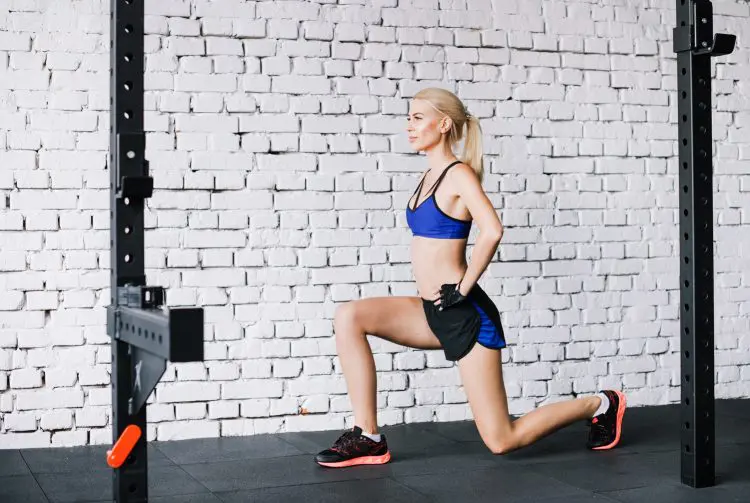
Steps:
- Start by standing upright.
- Step forward with your right leg while keeping the left leg in place.
- At this point, the lower right leg should be perpendicular, and the upper should be parallel to the floor.
- Your left upper leg should remain perpendicular to the floor throughout the exercise.
- Your right knee should not go beyond your toes while performing the lunges.
- Repeat for the recommended reps before switching sides.
Variations: A few lunge variations that should be a part of your leg training arsenal:
- Static lunges
- Reverse lunges
- Forward lunges
- Walking lunges
10. Trap Bar Jumps
With this exercise, we are heading into the pro exercise territory.
If your goal is to go viral on Instagram Reels with your high box jump videos, trap bar jumps will help you build the explosiveness you’ll need to set new records.
Steps:
- Grab a trap bar and get into a deadlifting position.
- Perform an explosive deadlift and jump as you reach the top of the movement.
- Return to the starting position and repeat for the desired reps without resting.
- Use weights that are not be too heavy for your knees, ankles, and joints.
11. Tuck Jumps
Tuck jumps can feel like burpees in disguise. You’ll see improvement in your high jumps if you make the tuck jumps a part of your training routine.
Steps:
- Get into a squatting position with your feet placed hip-distance apart.
- Perform a half-squat and jump into the air as you return to the starting position.
- Pull your knees in toward your chest while you are in the air.
- Land back in a half-squat position to avoid straining the knees and ankles.
How to integrate plyometric training into your program:
Warm-Ups
Performing the exercises mentioned above in a non-fatigued state will help you make significant gains in a short period. It is usually recommended that lifters perform more neurologically demanding and power-based movements before strength and conditioning segments as it improves performance and reduces the probability of an injury.
Sets and Reps
For most maximal explosive repetitions, it is recommended that total jumps per day be kept within the 8-15 rep range. Each set should not consist of more than three repetitions.
On the other hand, if your goal is to shed weight and build endurance, you should be performing these box jump variations to failure.
Some More Alternatives:
- Best Alternatives to Lunges for Bad Knees
- Crunches and Sit-Up Alternative
- Triceps Pushdown Alternatives
- Seated Cable Row Alternative
- Romanian Deadlift Alternatives
- Cable Crossover Alternatives
- Hip Thrust Alternatives for a Stronger Posterior Chain
- Back Extension Alternatives
- Leg Extension Alternatives
- Leg Curl Alternatives for Stronger Hamstrings
- Bench Press Alternatives For A Big, Powerful Chest
Conclusion
The question shouldn’t be if you should be adding plyometric exercises to your workout. A study published in 2016 showed that plyometric exercises like the variations mentioned above significantly improved physical fitness in team sport athletes.
Whether you are into bodybuilding, powerlifting, or CrossFit, plyometric movements have a place in your training routine.
Interested in measuring your progress? Check out our strength standards for Bench Press, Dumbbell Bench Press, Seated Cable Row, and more.

